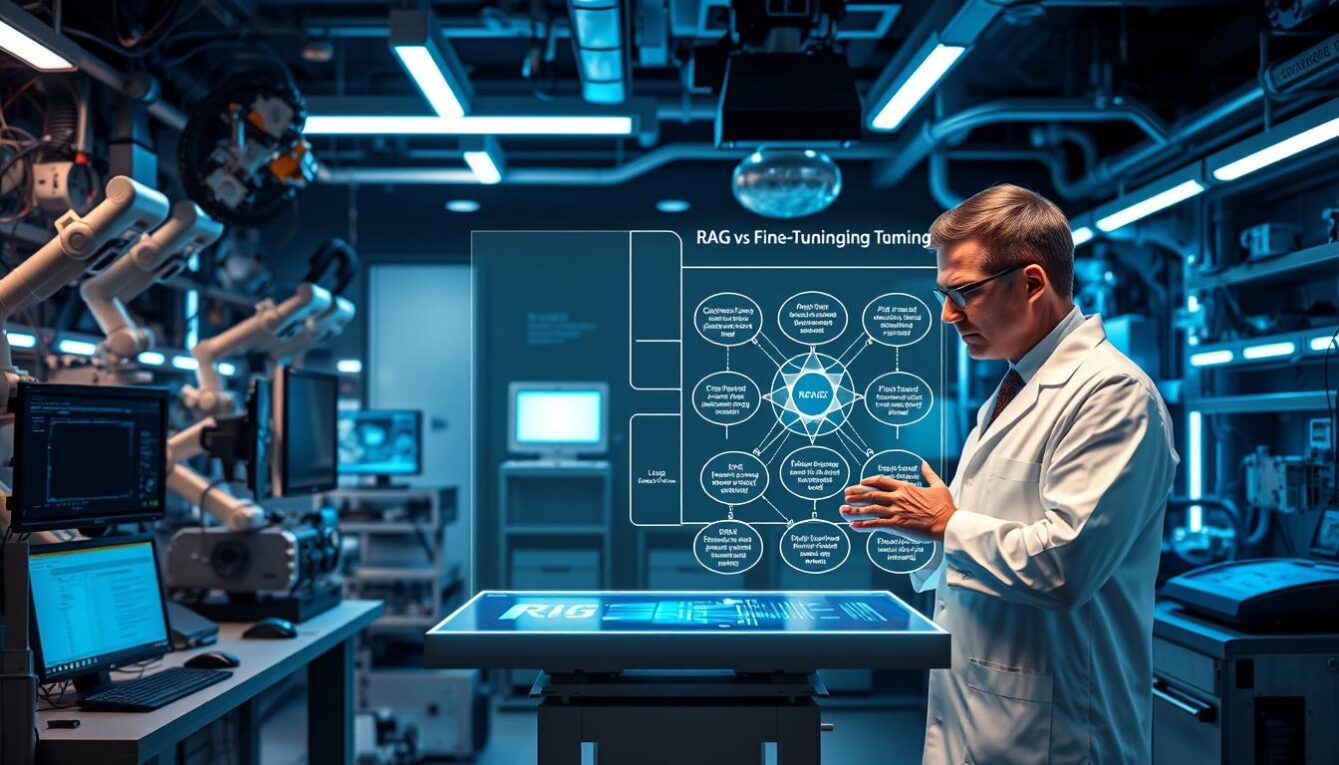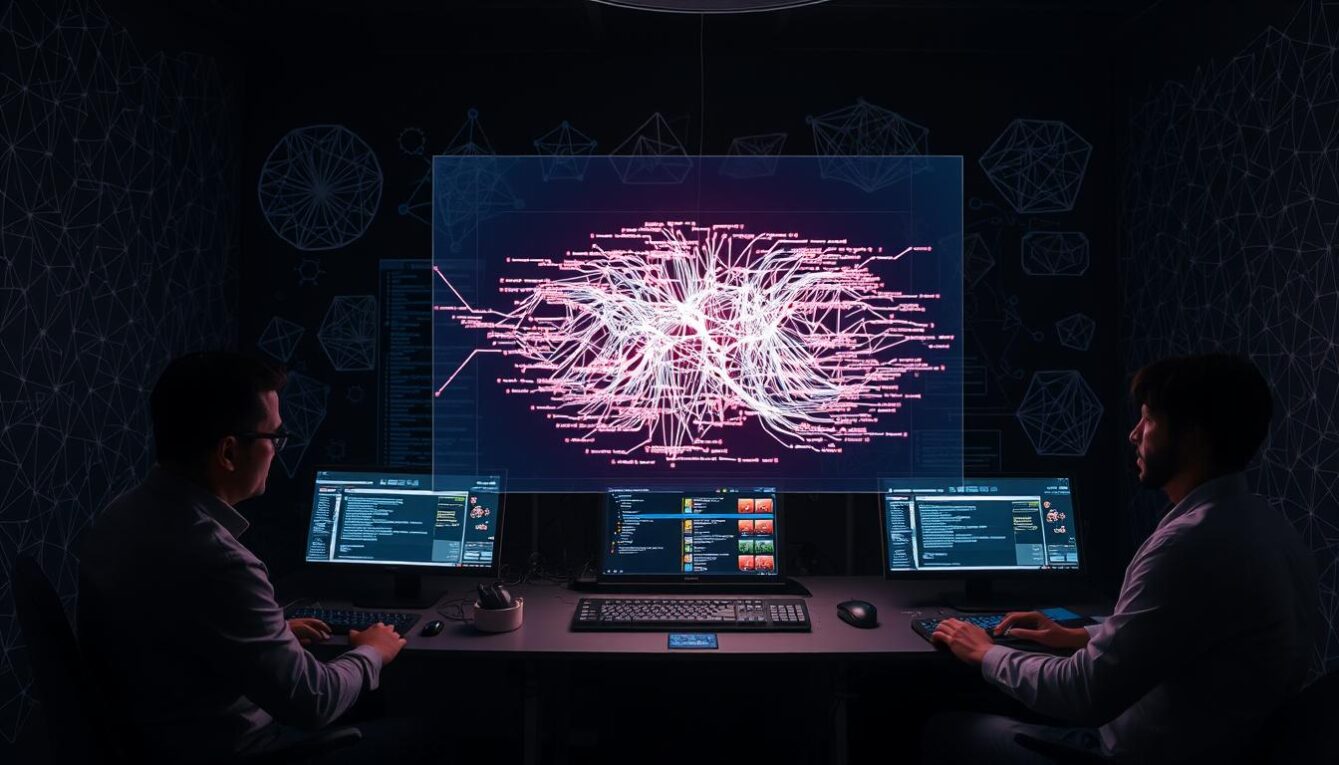When we talk about making large language models (LLMs) better, people often ask me about RAG and Fine-Tuning. A study found that about 70% of LLM projects fail because they’re not tuned right. This leads to big money losses and wasted effort.
This fact shows how crucial it is to pick the right way to make your LLM better. In this article, I’ll compare RAG and Fine-Tuning in detail. This will help you figure out which one is best for you.

I’ve worked on making communication tech better for years. I’ll share useful tips to help you make a good choice.
Key Takeaways
- Understand the fundamental differences between RAG and Fine-Tuning approaches.
- Learn how to choose the most suitable optimization strategy for your LLM.
- Discover the benefits and limitations of each approach.
- Gain practical insights from real-world experiences.
- Make informed decisions to optimize your LLM deployments.
Understanding RAG: A Comprehensive Overview
To make good choices about LLM strategies, knowing RAG is key. I’ve seen how RAG boosts LLM performance. It’s not just a trick; it’s a full plan that makes LLMs better.
What is RAG?
RAG means Retrieval-Augmented Generation. It mixes two ways to handle language: getting info and making text. This way, RAG models give answers that are right and make sense.
It works in two parts: getting info and making a response. First, it finds important stuff from a database. Then, it uses that info to make a smart answer.
Key Components of RAG
What makes RAG work well are its main parts:
- Retrieval Mechanism: This part finds the right info from a database. How well it does this affects RAG’s success.
- Generation Model: This is where the text is made. It uses the info found earlier. This model is based on transformers.
- Knowledge Base: This is where all the info comes from. How good this info is matters a lot for RAG’s success.
Benefits of Using RAG
Using RAG has many advantages:
- Improved Accuracy: RAG’s use of real info makes its answers better.
- Enhanced Relevance: It uses the right info to make answers that fit the question better.
- Flexibility: RAG can be used in many ways, like answering questions or making content, by changing how it works.
Exploring RAG shows it’s a strong tool for LLM Optimization and Strategy Selection. It helps make better choices when working with LLMs.
Exploring Fine-Tuning Strategies
In the world of LLMs, fine-tuning is a big deal. It helps make these models better for specific jobs. I’ve seen how it boosts a model’s skills.
What is Fine-Tuning?
Fine-tuning means tweaking a pre-trained LLM for a certain task. It lets the model learn special skills for that job. Fine-tuning is great for tasks that need to be very accurate.
The Fine-Tuning Process
First, pick a pre-trained LLM that fits the task. Then, get a dataset for that task. Use it to fine-tune the model. You might adjust settings or use transfer learning to help.
Advantages of Fine-Tuning LLMs
Fine-tuning makes LLMs work well on specific tasks with less data. It makes them flexible for new tasks. It also makes models more accurate and efficient.
Knowing about fine-tuning helps developers. They can make models better, adapt to new tasks, or improve efficiency.
Comparing RAG and Fine-Tuning: An Overview
Choosing the right strategy for LLMs is key. It’s about knowing the difference between RAG and Fine-Tuning. Each has its own strengths for different needs.
Key Differences
RAG and Fine-Tuning work in different ways. RAG uses external info to boost the model. Fine-Tuning tweaks the model with a specific dataset.
RAG’s main points are:
- It gets info on the fly.
- It doesn’t need a lot of retraining.
- It’s good at handling many kinds of questions.
Fine-Tuning has its own strengths:
- It’s made for specific tasks or datasets.
- It can do better on certain tasks.
- It needs a lot of computing power and data.
| Feature | RAG | Fine-Tuning |
|---|---|---|
| Approach | Info retrieval and boost | Adjusting model parameters |
| Training Need | Little retraining needed | A lot of retraining needed |
| Flexibility | Very flexible for many topics | Limited to fine-tuned task |
Use Cases for Each Approach
Choosing between RAG and Fine-Tuning depends on your project’s needs. RAG is great for keeping up with the latest news or answering many questions.
Fine-Tuning is best for tasks needing precision and customization. This includes legal or medical text analysis, where the model must fit the specific domain.
The Role of Data in RAG and Fine-Tuning
The success of RAG and fine-tuning depends a lot on the data. It’s key to know what data they need.
Data is very important for RAG and fine-tuning. It helps them work well in large language models (LLMs). I’ve worked a lot with LLMs. I know how important good data is.
Data Requirements for RAG
RAG needs good data to work well. Here’s what it needs:
- Relevant External Knowledge: RAG needs lots of relevant knowledge to find information.
- High-Quality Training Data: The data should be accurate, diverse, and well-organized. This helps the model learn well.
Data Considerations for Fine-Tuning
Fine-tuning adjusts a pre-trained model for a specific task. Here’s what it needs:
- Task-Specific Data: Fine-tuning needs data just for that task. This helps the model learn the task’s details.
- Data Quality and Quantity: Good data quality and enough data are both important. Good data helps the model learn right. Enough data helps it apply what it learned.
Knowing about data is key for a successful project with RAG or fine-tuning. By focusing on data needs, you can make your LLMs better.
Performance Metrics: How to Measure Success
Understanding the impact of RAG and fine-tuning on your LLM starts with the right metrics. You need to look at how well these strategies work using data.
Metrics for Evaluating RAG
For RAG, several important metrics help measure its success. These include:
- Precision: Shows how accurate the information is.
- Recall: Tells if the system finds all relevant info.
- F1-score: Balances precision and recall.
Tracking these metrics helps you make RAG better.
Metrics for Fine-Tuning Success
Fine-tuning focuses on how well the model does specific tasks. Key metrics are:
| Metric | Description | Use Case |
|---|---|---|
| Accuracy | Checks if the model gets tasks right. | Classification tasks |
| Perplexity | Sees if the model predicts well. | Language modeling |
| BLEU Score | Looks at text quality. | Text generation tasks |
These metrics show what’s good and what needs work in your fine-tuned model.

Using these metrics, you can make RAG and fine-tuning better. This helps your LLM work better.
Technical Considerations for Implementation
To make RAG or fine-tuning work in your LLM, you need to think about the tech you’ll use. Each method has its own tech needs. These needs can really affect your project’s success.
Infrastructure Needs for RAG
RAG needs a strong setup to work well. You’ll need a good place to store data, tools to find the right info, and a way to mix this info with your LLM.
- A reliable data storage system to manage the external knowledge base.
- Advanced retrieval mechanisms that can efficiently fetch relevant information.
- A seamless integration process to incorporate the retrieved information into the LLM.
Here’s a quick table of what RAG needs:
| Infrastructure Component | Description | Importance Level |
|---|---|---|
| Data Storage | Reliable storage for the external knowledge base. | High |
| Retrieval Mechanisms | Efficient mechanisms for fetching relevant information. | High |
| Integration Process | Seamless integration of retrieved information into the LLM. | Medium |
Tools and Frameworks for Fine-Tuning
Fine-tuning LLMs needs special tools and frameworks. Hugging Face Transformers, TensorFlow, and PyTorch are good choices. They help with the fine-tuning process. You might also need custom scripts for your specific needs.
Knowing the tech needs for RAG and fine-tuning helps plan your LLM Optimization project. This way, you can make sure it works as you want it to.
Cost Implications: RAG vs. Fine-Tuning
When choosing between RAG and fine-tuning, think about the costs. These costs can affect your project’s budget and plan.
Cost Factors for RAG
RAG has several costs. These include:
- The cost of developing and maintaining the retrieval infrastructure.
- Expenses related to storing and managing the external knowledge base.
- Computational costs associated with retrieving relevant information.
Table: Cost Factors for RAG
| Cost Factor | Description | Estimated Cost |
|---|---|---|
| Infrastructure Development | Cost of setting up retrieval infrastructure | $5,000 – $10,000 |
| Knowledge Base Management | Expenses for storing and managing external knowledge | $2,000 – $5,000 |
| Computational Costs | Costs associated with information retrieval | $1,000 – $3,000 |
Budgeting for Fine-Tuning Initiatives
Fine-tuning also has costs. These include:
- The cost of acquiring and preparing high-quality training data.
- Computational resources required for fine-tuning the model.
- Potential costs associated with model updates and maintenance.
Knowing these costs helps you make a better choice. Whether you pick RAG or fine-tuning, budgeting well is key for your LLM project’s success.
Table: Budgeting for Fine-Tuning
| Budget Item | Description | Estimated Cost |
|---|---|---|
| Training Data Acquisition | Cost of acquiring high-quality training data | $3,000 – $8,000 |
| Computational Resources | Costs associated with fine-tuning the model | $2,500 – $6,000 |
| Model Maintenance | Potential costs for model updates and maintenance | $1,500 – $4,000 |
Scalability: RAG and Fine-Tuning in Practice
Scaling RAG and fine-tuning is key for LLM projects. As projects get bigger and data grows, we need methods that keep up. They must work well even when demands increase.
Scaling RAG models needs careful thought. The setup must handle big datasets and complex queries. Optimizing the retrieval mechanism is crucial for quick and accurate info. Using advanced RAG techniques can also help.
Scaling RAG Models
To scale RAG models well, focus on the retrieval component. Improve algorithms and make sure the setup can handle more. Distributed computing and load balancing can help.
Also, the quality of knowledge sources matters a lot. As models grow, keeping sources relevant and up-to-date is vital. Regular updates and good filtering are key.
Scalability Challenges with Fine-Tuning
Fine-tuning LLMs has its own challenges. The computational cost of fine-tuning big models is high. Parameter-efficient fine-tuning can reduce costs by updating fewer parameters.
Another issue is overfitting with big models and small datasets. Overfitting happens when models are too complex. Regularization and early stopping can help prevent this.
In summary, scaling RAG and fine-tuning needs careful planning. We must think about infrastructure, data quality, and resources. This way, LLM projects can grow and handle more complexity.
User Experience: Engagement and Results
User experience is key to your LLM project’s success. We’ll look at how RAG and Fine-Tuning affect user engagement and happiness.
Enhancing User Interaction with RAG
RAG models give better and more relevant answers by using a huge knowledge base. This makes talking to them more fun and helpful. They can answer a lot of different questions and topics.
- More precise answers to complex queries
- A more engaging experience through dynamic response generation
- The ability to handle a wider range of topics and questions
Experts say, “Adding retrieval to generative models is a big step. It makes user experiences more informative and fun.”
— LLM Research Team
User Satisfaction with Fine-Tuned Models
Fine-Tuning LLMs makes them better for specific tasks or areas. This leads to happier users. The good stuff includes:
| Benefit | Description | Impact on User Satisfaction |
|---|---|---|
| Domain-specific knowledge | Fine-Tuned models know a lot about certain areas. | Answers are more accurate and relevant. |
| Customized responses | Models can be made to fit specific needs or styles. | Users feel more connected and understood. |
| Improved performance | Fine-Tuning makes models better at certain tasks. | Users can get things done faster and better. |
By making user experience a top priority, developers can make LLMs that go beyond what users expect.
Making the Right Choice: Factors to Consider
When we finish talking about RAG and fine-tuning, think about what your project needs. This will help you pick the best way to make your LLM better.
Evaluating Project Needs
Look at how complex your project is. Also, think about the size and type of your data. And what do you want to achieve?
If you need to quickly change your model for new data, RAG might be better. But if you want to make your model really good at one thing, fine-tuning could work better.
Best Practices for Decision-Making
When deciding, think about how big your project can grow, how much it will cost, and how easy it is to use. By looking at these things, you can pick the best strategy for your goals.
Make sure to check if your setup can handle the project. Also, think about how much data you need and how well the model will perform. This will help you do a great job.










